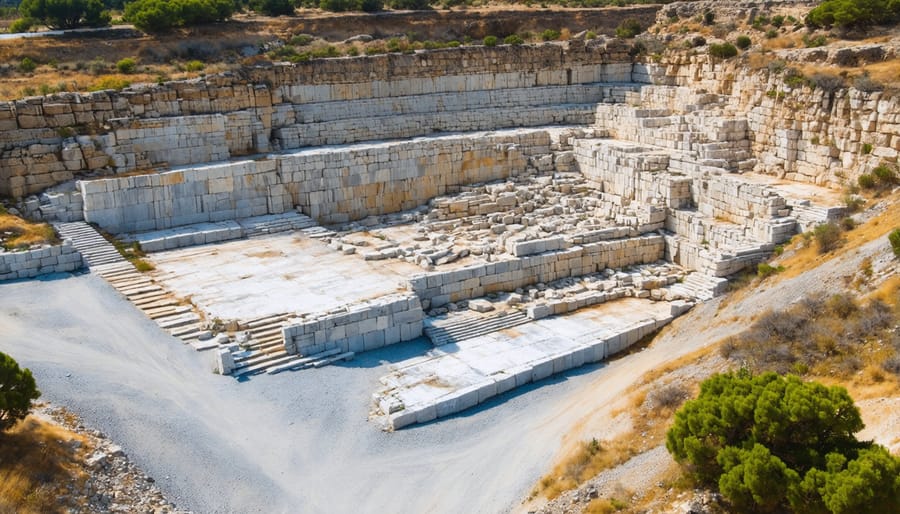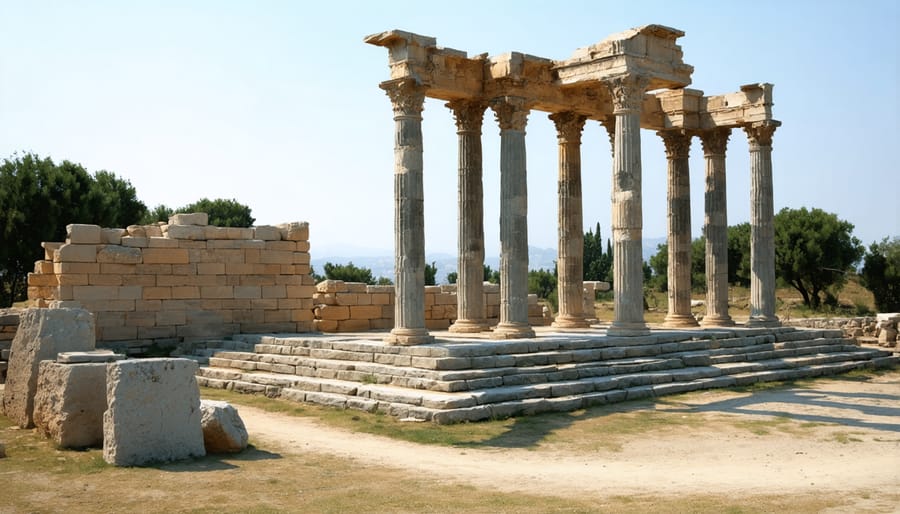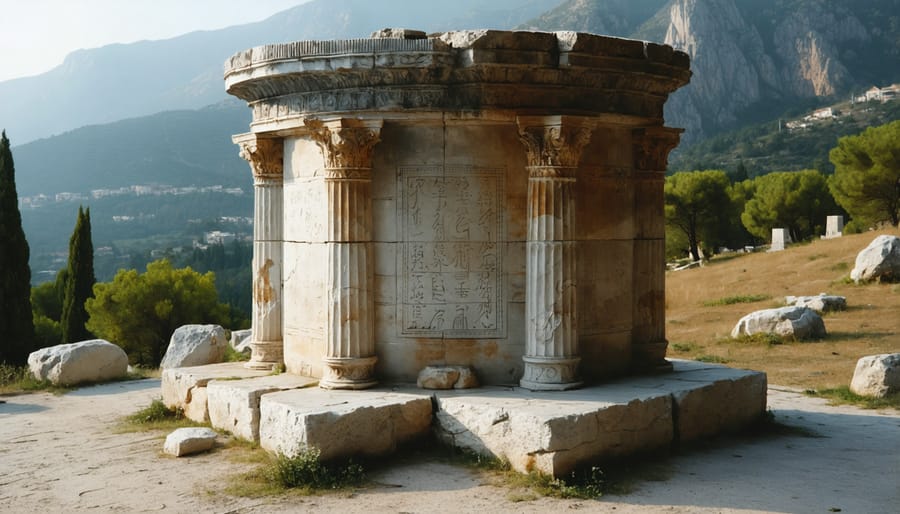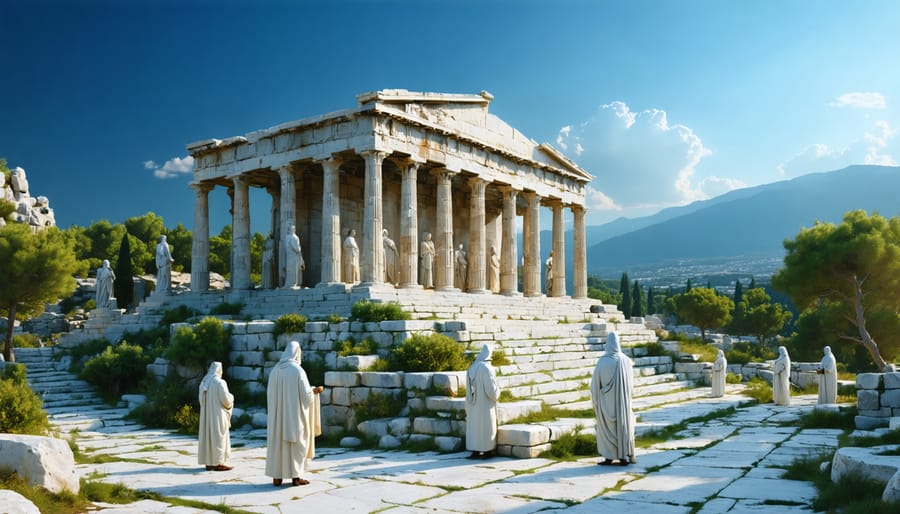In the sun-bleached temples and sacred groves of ancient Greece, rituals weren’t merely religious ceremonies—they were the vital threads that wove together the fabric of Greek society. From the majestic ancient Greek marble monuments to the humble household altars, every sacred space served as a stage where mortals sought connection with the divine. These carefully choreographed ceremonies, ranging from grand state-sponsored festivals to intimate family offerings, reflected a sophisticated understanding of the relationship between humans and their gods.
The Greeks approached their rituals with a precision that bordered on scientific methodology, yet maintained a deep spiritual reverence that transformed simple actions into profound religious experiences. Each libation poured, animal sacrificed, or prayer uttered followed ancient protocols passed down through generations of priests and priestesses. These practices weren’t just expressions of piety—they were considered essential transactions with the divine, maintaining the delicate balance between the mortal and immortal realms.
Understanding these rituals provides crucial insight into not just Greek religion, but the very foundation of Western civilization’s relationship with the sacred. Their influence continues to echo through time, visible in modern religious practices and cultural ceremonies that still carry traces of these ancient observances.
The Sacred Geography of Stone
Sacred Quarries
Ancient Greeks believed certain quarries held divine significance, designating them exclusively for temple construction. These sacred stone sources were carefully selected through religious ceremonies and divination practices, with priests and oracle consultations often determining their locations. The most renowned sacred quarry was at Mount Pentelikon, which provided the gleaming white marble used in the Parthenon and other major temples on the Acropolis.
Before extraction began, workers performed purification rituals and made offerings to the gods, particularly to Athena and Apollo. The quarrying process itself followed strict religious protocols, with specific days and lunar phases deemed more favorable for extraction. Workers often carved small shrines into the quarry walls and left votive offerings to ensure divine protection during their dangerous work.
The transportation of stone blocks from sacred quarries to temple sites was also ritualized, with processions and ceremonies marking the journey. These carefully extracted stones were believed to carry divine essence, making them integral to a temple’s spiritual power. Even today, ancient quarry sites show evidence of these religious practices through discovered artifacts and carved inscriptions.

Stone Selection Ceremonies
The selection of stones for temple construction in ancient Greece was far more than a mere architectural decision – it was a deeply spiritual process steeped in ritual significance. The sacred meanings of stone influenced every aspect of the selection ceremony, from the timing to the participants involved.
Priests and master craftsmen would gather at dawn during specific lunar phases to examine potential quarry sites. They performed libations to the gods, particularly Apollo and Athena, before any stone could be extracted. The ceremony involved purification rites where both the quarry site and the workers were cleansed with sacred water and fumigated with burning herbs.
Before extraction began, diviners would interpret natural signs and omens, such as bird flights or weather conditions, to ensure divine approval. The first cut into the stone face was made only after receiving favorable omens, accompanied by prayers and the sacrifice of a young goat or sheep. The blood from these sacrifices was sometimes used to mark the stone, believing it would imbue the material with divine protection during its journey from quarry to temple.
Temple Construction Rituals
Foundation Ceremonies
The foundation laying of ancient Greek temples involved intricate sacred stone rituals that marked the transition of ground from mundane to sacred space. Priests would first purify the site through libations of wine, water, and honey, followed by the sacrifice of animals whose blood would consecrate the earth. The cornerstone ceremony was particularly significant, with the first stone block carefully positioned at sunrise during astrologically favorable days.
Archaeological evidence reveals deposits of precious objects beneath temple foundations, including bronze figurines, pottery, and coins. These foundation deposits served as offerings to chthonic deities and were believed to ensure the temple’s stability and divine protection. The ceremony often included the placement of specially inscribed stones containing the temple’s dedication and purpose.
The entire community typically participated in these ceremonies, with civic leaders, priests, and citizens gathering to witness the ritual marking. Musicians played sacred hymns while attendants burned incense, creating an atmosphere of reverence. The foundation ceremonies could last several days, incorporating processions, prayers, and communal feasts.
These rituals reflected the Greeks’ belief that proper ceremonial observation was essential for establishing a successful connection between the mortal and divine realms, ensuring the temple would serve as an effective house of worship for generations to come.
Column Raising Rituals
The raising of temple columns in ancient Greece was not merely a construction process but a deeply sacred ritual that combined engineering precision with religious devotion. Before erection, each column drum underwent purification ceremonies where priests would sprinkle holy water and burn incense to cleanse the stone of earthly impurities.
The actual raising ceremony typically began at dawn, chosen for its symbolic connection to Apollo, god of light and order. Workers and priests would gather around the construction site, offering prayers and libations to Athena, patron goddess of crafts, and Hephaestus, god of metallurgy and masonry. Special hymns were chanted as each column section was carefully lifted into place.
As the final drum was positioned, priests would perform the “binding ritual,” symbolically uniting the column with both earth and sky. This involved circling the column three times while reciting sacred verses and placing small offerings of grain, honey, and wine at its base. The ceremony concluded with the application of the final surface treatments, each stroke of the mason’s tools accompanied by specific prayers.
These rituals weren’t just spiritual exercises – they also served practical purposes, ensuring careful attention to detail during construction and fostering a sense of communal pride in these monumental structures. Many of these ceremonies were documented on temple building records, providing valuable insights into both the technical and religious aspects of ancient Greek architecture.

Stone Altars and Sacrificial Spaces
Altar Design and Symbolism
Ancient Greek altars served as the focal point of religious ceremonies, carefully designed and positioned to maximize their spiritual significance. These structures varied in size from small household shrines to massive public monuments, typically constructed from locally sourced limestone or marble.
The most common altar design featured a rectangular base with steps leading to a flat upper surface where offerings were placed. This elevated platform symbolized the connection between the mortal and divine realms. Many altars incorporated decorative elements such as carved reliefs depicting mythological scenes or geometric patterns that held specific religious meaning.
The placement of altars followed strict religious guidelines. In temples, they were typically positioned outside the main building, facing east toward the rising sun. This orientation was believed to channel divine energy and facilitate communication with the gods. Large public altars were often situated in prominent locations within city centers or sanctuaries, emphasizing their role in community worship.
The height and scale of an altar often corresponded to the deity it honored. Zeus’s altars were typically the tallest, while those dedicated to chthonic (underworld) deities were sometimes built at ground level or partially buried. The altar’s material quality and craftsmanship reflected both the importance of the deity and the wealth of the community it served.

Ritual Usage Patterns
Stone elements played crucial roles in ancient Greek religious ceremonies, serving both practical and symbolic purposes. Altars, typically constructed from limestone or marble, formed the centerpiece of sacrificial rituals where offerings were made to the gods. These structures varied in size from simple household shrines to massive temple altars capable of hosting city-wide ceremonies.
Temple thresholds held particular significance, often featuring carved symbols and inscriptions that marked the transition from secular to sacred space. Worshippers would pause at these stone boundaries to purify themselves before entering. Stone basins, known as perirrhanteria, contained holy water for ritual cleansing and were strategically placed at temple entrances.
In mystery cult ceremonies, underground stone chambers created atmospheres of reverence and secrecy. The Eleusinian Mysteries, for example, utilized carved stone seats arranged in theatrical formations where initiates would witness sacred rites.
Votive offerings were frequently placed in stone niches or on purpose-built stone pedestals. These dedicated spaces, carefully integrated into temple architecture, allowed worshippers to leave permanent tributes to their chosen deities. Stone offering tables, some featuring carved channels for libations, facilitated the precise performance of ritual protocols established by religious tradition.
Stone in Funerary Practices
Stone played a central role in ancient Greek funerary practices, serving both practical and symbolic purposes in death rituals and remembrance. The most visible manifestation was the stone grave marker, or stele, which evolved from simple limestone blocks to intricately carved marble monuments depicting scenes from the deceased’s life or idealized representations of departure.
Wealthy families commissioned elaborate stone sarcophagi, often decorated with relief sculptures showing mythological scenes or important moments from the deceased’s life. These stone coffins not only preserved the body but also served as lasting monuments to the dead. The durability of stone made it the perfect medium for ensuring eternal remembrance, a crucial concept in Greek beliefs about the afterlife.
In burial grounds, stone cippi (boundary markers) delineated family plots and sacred spaces. Underground tomb chambers were typically carved from natural rock or constructed using carefully cut stone blocks. These chambers often featured stone benches for offerings and stone vessels for libations, reflecting the Greek belief in continuing relationships with the deceased through regular rituals.
The choice of stone was significant, with different types carrying distinct meanings. White marble symbolized purity and divine connection, while darker stones like basalt were sometimes used to convey solemnity. Local limestone was common for simpler memorials, while imported marble indicated higher status.
Stone also featured prominently in mourning rituals. Mourners would place small stones on graves as tokens of remembrance, a practice that symbolized the permanence of memory. This tradition emphasized stone’s role as a bridge between the world of the living and the realm of the dead.
Modern Preservation of Ancient Stone Rituals
Modern preservation efforts of ancient Greek stone ritual sites combine cutting-edge technology with traditional conservation methods to protect these irreplaceable cultural treasures. The enduring legacy of stone continues to captivate archaeologists and conservationists who employ 3D scanning, photogrammetry, and advanced chemical treatments to document and preserve ritual spaces.
At sites like Delphi and Eleusis, experts use non-invasive monitoring systems to track environmental impacts on stone structures. These systems measure factors such as temperature fluctuations, moisture levels, and air pollution that could compromise the integrity of ancient stones. Specialized conservation teams apply protective coatings that shield the stone while maintaining its authentic appearance and allowing it to breathe naturally.
Digital preservation has become equally important, with international organizations creating detailed virtual archives of ritual sites. These archives serve multiple purposes: they provide reference points for restoration work, enable virtual access for researchers worldwide, and ensure that future generations can study these sacred spaces even if physical deterioration occurs.
Local communities also play a vital role in preservation efforts, with many sites incorporating traditional knowledge and maintenance practices passed down through generations. This combination of modern technology and ancestral wisdom helps ensure that these stone sanctuaries continue to tell their stories for centuries to come.
The enduring legacy of ancient Greek stone rituals continues to influence modern architecture and cultural practices. From the precise geometric patterns found in contemporary civic buildings to the use of marble in government structures, these classical elements echo the sacred stone traditions of ancient Greece. Modern architects frequently draw inspiration from Greek temples’ proportions and column designs, while public spaces often incorporate stone elements that recall ancient gathering places for ceremonies. The spiritual connection between stone and civilization that the Greeks established remains relevant today, visible in everything from memorial monuments to ceremonial buildings. This lasting impact demonstrates how deeply ingrained these ancient practices are in our cultural consciousness, bridging thousands of years of architectural and spiritual tradition through the timeless medium of stone.










